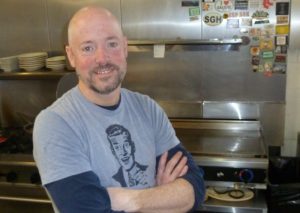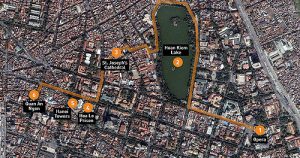What a timely module for me as I continue to develop my project, Nashville Sites. The process in thinking about and executing this project mirrors the complexities of doing digital public history specifically tied to a place. In my case — that place is Nashville, Tennessee.
Our readings discussed the use of Storyteller (World War One: Love and Sorrow), responsive design (Beyond the Screen), combining oral history and place (Cleveland Historical), and augmented reality (PhillyHistory.org).
According to Deborah Boyer and Josh Marcus, “Learning about the history of a neighborhood in a classroom is educational, but actually standing in a neighborhood and comparing historic images to the present landscape can inspire students to engage more deeply with the past” (“Implementing Mobile Augmented Reality Applications for Cultural Institutions”). I couldn’t agree more. Speaking of more, my goal for Nashville Sites also includes a public audience in addition to students and scholars. Further sub-dividing, my audience is also composed of Nashville residents as well as a wide range of visitors to the city.
The Cleveland Historical site is nearly identical to Spokane History and feature walking tours and geo-spatial mapping. However, they are not as engaging for the mobile user. The text is lengthy and rather than giving the user the opportunity to view the site with a lead-in line to draw them to the longer description, the only option is to view the longer description. It also lacks the navigability and mapping options utilized by the Histories of the National Mall.
The PhillyHistory is a much bigger project that involves augmented reality using historic photographs in real-time and place. They began with a small sample size but have now incorporated thousands of images. This project involved a system called Layar. It was interesting to think about the two categories of applications: GPS-based and computer-vision based. As authors Boyer and Marcus note, “GPS-based applications make use of a phone’s GPS and accelerometer, gyroscope, and other technology to determine the location (particularly in urban areas), heading, and direction of the phone.” Most impressive has been the response to PhillyHistory (and this article was published in 2011): the site has 6,400 registered users and regularly receives and average of 13,000 unique visitors per month. These metrics remind me that I need to circle back to the MHC to see just what the stat counters say for the nashville.gov site that lists Nashville’s historical markers. The director told me it had the most traffic, but I need to get firm numbers.
World War One: Love and Sorrow is place-based public history but focused on a different type of location. Rather than an urban environment, it seeks to create a unique user experience in Museum Victoria. It does a nice job of storytelling and creating an engaging narrative as users can progress through the museum while also choosing and following one individual’s story (an actual veteran of the war) that features accompanying primary source documents. The project creates a compelling and personal narrative that makes the museum and exhibit more exciting for the patron/user. While a great project, with some elements that made me think about how to create a compelling narrative within my own project, this place-based history is equally, if not more, thematic. The place is the museum, which drives the project technically but not theoretically.
The final article “Beyond the Screen,” was so relevant that I read it twice. It really helped inform me in thinking about my own project. I spent quite a bit of time taking notes and internalizing concepts such as graceful degradation, responsive design, progressive enhancements, and the triad: 1- What they want, 2- When they want it, 3- How they want it. John Falk’s description of the five visitor/motivation types was also extremely useful: 1- explorer, 2- experience seeks, 3- recharger, 4- professional/hobbyist, and 5- facilitator. Several museums and projects were referenced as well as new technologies that I’ve since checked out, which include: Foursquare, Field Trip, Google Street, and Google Now. I learned a great deal from this white paper in general, but it also made me conceptualize my own project in a more objective and productive way. For example, I could easily include a guest survey to get feedback, create a journey map, and use Neatline to create a timeline that would create a chronological complement to the place-based history I am trying to create.
Audiences, and people in general, have an attention span that averages 3-12 seconds. With that in mind, I have to find a way to get the audience to the site and find ways to keep them interested. As the authors of “Beyond the Screen,” conclude: “While content is kind, if even the bride-to-be doesn’t notice her very own diamond ring in a case in front of her, it’s worth investigating new modes and opportunities that create responsive, customized experiences that entertain, engage, and enrich.”
Works Cited:
Hart, T. and Brownbill, J. “World War One: Love and Sorrow – A hybrid exhibition mobile experience.” In Museums and the Web Asia 2014, N. Proctor & R. Cherry (eds). Silver Spring, MD: Museums and the Web. Published September 19, 2014.
Baer, Brad, Emily Fry and Daniel Davis. “Beyond the Screen: Creating interactives that are location, time, preference, and skill responsive.” MW2014: Museums and the Web 2014. Published February 1, 2014.
Tebeau, Mark. “Listening to the City: Oral History and Place in the Digital Era.” Oral History Review 40.1 (2013): 25-35.
Boyer, D. and J. Marcus. “Implementing Mobile Augmented Reality Applications for Cultural Institutions.” In J. Trant and D. Bearman (eds). Museums and the Web 2011: Proceedings. Toronto: Archives & Museum Informatics. Published March 31, 2011





